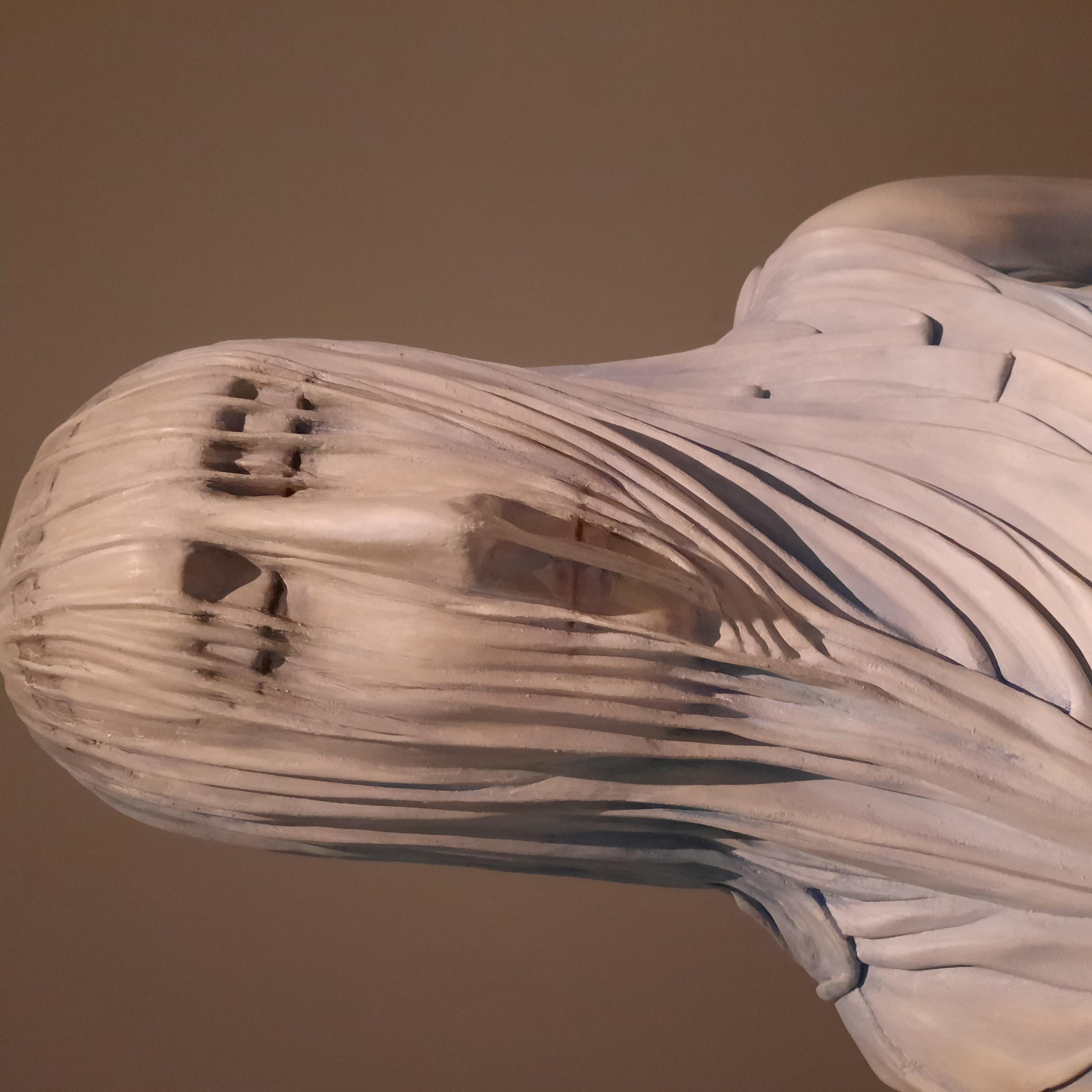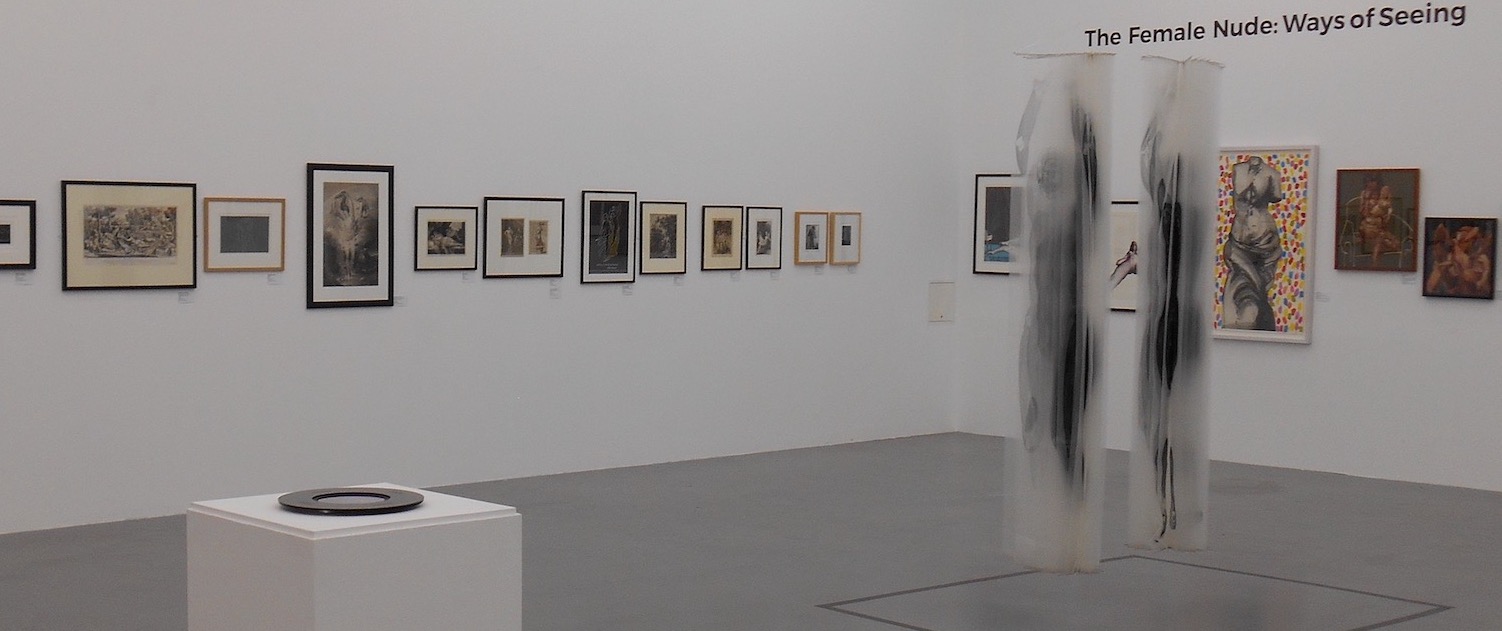Remember based on an interview with Ana Maria Pacheco

Something curious happened during the making of Remember: the piece became more diffuse as the artist worked, developing centrifugally and losing its centre, so that it evolved beyond any unifying story or stance. The pale, limp figure held up by two men at the foot of a step-ladder was the starting point. An anaemic ‘Christ’ descending from (or ascending to) an absent cross, his vulnerable mortality appears pathetic. Too weak to redeem a world defined by solitary suffering and sporadic violence. Perhaps we hear a distant echo of the appalled grief of Gilgamesh at the incomprehensible and unacceptable death of his beloved friend Enkidu? ‘There is no permanence’ is the harsh truth that once-mighty king learnt at the end of his wanderings. Or as Pacheco puts it: ‘the tragic realisation that we have no real control’.
The process of making, in this case prolonged by Covid lockdowns and enhanced by a generous grant from the Williams Charitable Trust, became a serious investigation, a difficult struggle in pursuit of the now missing centre. A search for meaning by means of recollection (Remember is the artist’s note to self, as well as an injunction to the beholder), intuition, and, of course, carving and painting. The precise control required to grasp at what is elusive is best figured in the detail of the veiled woman. This technical feat of wood carving was inspired by the cover of a paperback of Greek tragedy. It suggests the ‘veil of Isis’ obscuring the truths of nature. Yet the figure reacts, as her hands show, to the suffering in front of her, although with closed eyes: a form of insight or far-seeing divination? This mantic woman is distinguished from a chorus of four other ‘super-real’ (to use Anita Seppilli’s term) female figures by being painted blue in contrast to their white robes and staring, open eyes. These witnesses – mourners? – recall the expressive gestures and heightened emotions of Niccolo dell’Arca’s terracotta Pietà in Bologna (images of which I remember seeing pinned to the walls of Pacheco’s studio along with photographs of Syrian refugees back in 2020). From face to face we see the escalation of sympathy into trauma, and the tug of reality that draws down the spiritual into our tarnished world through the magnetic force of pain. Seated on the floor are bewildered and displaced people, five of them sheltering three children, their faces anxiously scanning for peril or withdrawn as they numbly struggle with fate. A further group of four men fight. Their angular gestures and twisted faces radiate violence. Hands grip clothes in an aimless and angry push and pull. Somewhat larger than the other figures in the sculptural group they could be the cause, or quite possibly the result, of the dark event unfolding before us? Seated on a red suitcase, picked out by a spotlight, a boy pensively assesses the cruel circumstances shaping the beginning of his life’s journey.
Moving amongst the figures the beholder responds to the valences at play across the group: their capacity to unite and combine across space, and then break apart again. From one angle, the blue-robed, veiled woman appears to bless yet also to be imagined by the ruminating, sitting man dressed in grey and brown. His thoughts are reflected in the eyes of the boy perched on top of the red case (a younger version of the same self?). The most frantic of the ‘witnesses’ stares fixedly and open-mouthed at the struggling men. They are also the object of the pained gaze of the semi-naked and bald man held upright at the base of the ladder by two ‘bearers’. He in turn is viewed with startled empathy by a seated woman in a red dress and grey-green robe who cradles a naked infant in her lap, who for her part looks towards a seated family group. And so on, each new encounter proliferating meanings. There are telling details too. The top knot of one violent man, the hoody of another, the irregular teeth of all four. Or, the hair-bands of a smiling infant creating comic horns, or again the up-swept quiff of one of the two ‘bearer’ figures. Is the latter responding to gel, sweat, or a gust of inspiration? Such specifics keep anchoring our response in reality whenever the temptation to generalise becomes too strong. Remember is not an abstract philosophical enquiry but a direct encounter with life.
This is the power of sculpture: its tangible, three-dimensional presence elicits a bodily as well as an intellectual response. Furthermore, the somewhat larger-than-life size of the figures, and the low levels of lighting, shift the normal threshold of our perception, provoking a wondering, questioning, even fearful state of mind. Our sense of space and with it time are subtly elongated. An interest in neuroscience informs these intentional manoeuvres, but the artist also concedes the similarity to the casting of a magic spell: a shamanistic shaping of an environment favourable to a cathartic and dramatic effect. The past is conjured up in the present and transformed through its re-presentation. It is a sacred and awful process, and therefore one that keeps alive the possibility of hope through memory’s attachment to things, and its re-shaping of events. We become involved among these figures of humanity in the question urgently asked by William Blake: ‘What the hand dare seize the fire? / And what shoulder & what art / Could twist the sinews of thy heart?’
When we spoke, Pacheco expressed an interest in Anita Seppilli, the Italian literary scholar who took refuge in Brazil from Mussolini’s racial laws, recalling the Italian-flavoured Portuguese spoken at Sao Paulo. It came as no surprise to her that Seppilli’s thoughts turned to magic in Brazil, where the beliefs of indigenous peoples rubbed up against the peasant culture of Portuguese and Italian immigrants, and the animism of former slaves of African origin. The potent Baroque of Brazilian Catholicism can be added to this mix. Considering Seppilli’s argument that magic declined into poetry, freeing up individual expression at the expense of the loss of unifying myths, Pacheco agreed that the mythical references in her art – more common in painting and prints than in sculpture – are personal and fragmentary, and not susceptible to iconographical (or even psychoanalytical) decoding. If a minotaur lurks in a Piranesi dungeon, or Anubis confers with shadowy seers, as they do in the impressive drypoints exhibited in Poetry & Magic, they are not elusive clues to a mystery but symbols deployed poetically, metaphors that deepen a tragic mood.
